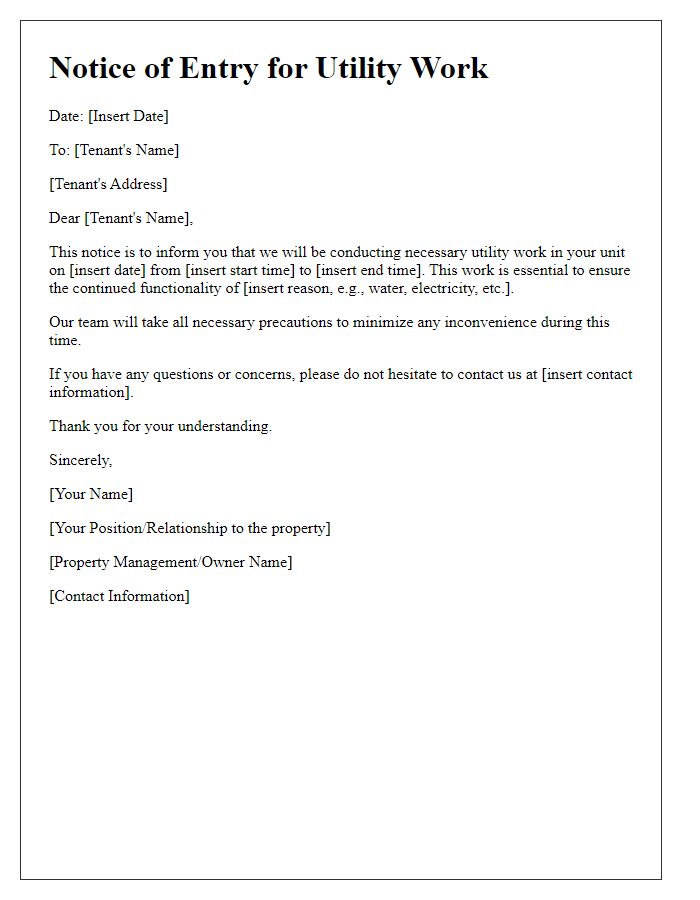Hey there! If you're a landlord or property manager, you know that notifying your tenants about entry to their unit is essentialâbut it doesn't have to be a hassle. Crafting a clear and concise notice can not only keep you compliant with local laws but also foster a good relationship with your tenants. In this article, we'll guide you through the key elements of an effective tenant notice of entry, ensuring that both parties are on the same page. Ready to learn how to create the perfect notice? Let's dive in!

Clear Header Information
A tenant notice of entry requires clear header information to avoid confusion about the purpose of the communication. The header should include essential details such as the property address (including street number, street name, city, and postal code), the name of the landlord or property management company, and a date for the notice to establish a timeline. Also, the notice should indicate a clear subject line, such as "Notice of Entry" or "Tenant Entry Notification," to provide immediate context. Additionally, including legal references or local ordinances regarding tenant rights and entry regulations can enhance the document's authority, ensuring that tenants understand their rights and the reason for the entry.
Purpose of Entry
Landlords may need to enter rental properties for various reasons, such as routine inspections, repairs, or to show the unit to prospective tenants. Notices should specify the date and time of entry, following local laws which typically require 24 hours' notice to tenants. These guidelines help maintain transparency and respect the tenant's privacy rights granted by housing statutes. Proper phrasing ensures clear communication without misunderstandings, fostering a positive landlord-tenant relationship while complying with legal obligations.
Date and Time of Entry
Notice of Entry serves as an official communication to inform tenants regarding access to their rented property by the landlord or authorized personnel. Standard practice dictates that tenants receive this notice at least 24 hours in advance, per local tenant laws. This notice should clearly specify the date, such as March 15, 2023, and time range of entry, for instance, 1 PM to 4 PM. Entry may be necessary for routine inspections, repairs, or maintenance work, crucial for ensuring the property's upkeep and addressing safety issues. Providing a contact number for additional inquiries enhances transparency, fostering a better relationship between the tenant and landlord while adhering to legal obligations.
Contact Information
A tenant notice of entry must include the property address, specific date and time of entry, and reason for access. Typically, landlords notify tenants via written communication, ensuring clarity. For instance, in a multi-unit building like Maple Grove Apartments located in Chicago, Illinois, notifying tenants at least 24 hours in advance is standard, complying with Illinois Residential Tenant Ordinance. Essential contact information includes the landlord's name, phone number, and email address to facilitate any necessary communication. When indicating entry for maintenance work, such as plumbing repairs or an inspection, it's crucial to provide details regarding the service provider or maintenance personnel involved, enhancing transparency and fostering trust between landlords and tenants.
Legal Compliance and Consent
Landlords must provide written notice to tenants before entering rental properties, ensuring legal compliance under state laws. Typically, notice periods range from 24 to 48 hours, depending on jurisdiction, such as California's Civil Code Section 1954. Notices should include specific dates and times, outlining reasons like repairs or inspections. Clear consent is required from tenants for non-emergency situations, emphasizing rights to privacy and peaceful enjoyment of the residence. Documenting this communication strengthens relationships and adherence to legal standards while setting expectations for both parties.













Comments